Citizenship United States Role Journalist Name Ancel Keys | Nationality American | |
 | ||
Born Ancel Benjamin KeysJanuary 26, 1904Colorado Springs, Colorado ( 1904-01-26 ) Alma mater Died November 20, 2004, Minneapolis, Minnesota, United States Spouse Margaret Keys (m. 1939–2004) Education Books How to Eat Well and Stay Well, Seven Countries: A Multivar, The Biology of Human St, The Benevolent Bean, Adventures of a Medical S | ||
Residence United States of America | ||
3 the journalist gary taubes 3 ancel keys was very bad 1
Ancel Benjamin Keys (January 26, 1904 – November 20, 2004) was an American physiologist who studied the influence of diet on health. In particular, he hypothesized that dietary saturated fat causes cardiovascular heart disease and should be avoided.
Contents
- 3 the journalist gary taubes 3 ancel keys was very bad 1
- 4 the journalist gary taubes 4 ancel keys was very bad 2
- Early life
- Higher education
- Early physiology studies
- Development of K rations
- Starvation study
- Seven Countries Study
- Keys equation
- The sugar controversy
- BMI and other contributions
- Personal life
- References

Keys studied starvation in men and published The Biology of Human Starvation (1950), which remains the only source of its kind. He examined the epidemiology of cardiovascular disease (CVD) and was responsible for two famous diets: K-rations, formulated as balanced meals for combat soldiers in World War II, and the Mediterranean diet, which he popularized with his wife Margaret. Science, diet, and health were central themes in his professional and private lives.
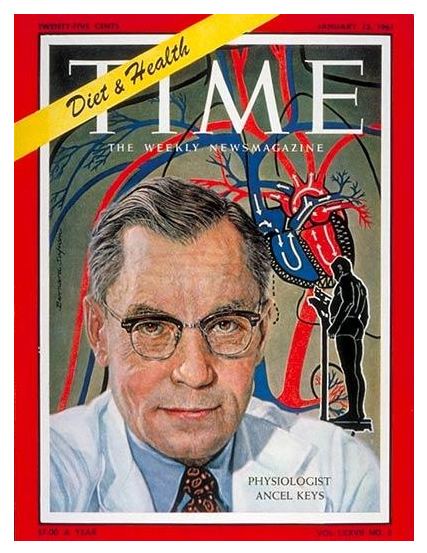
4 the journalist gary taubes 4 ancel keys was very bad 2
Early life
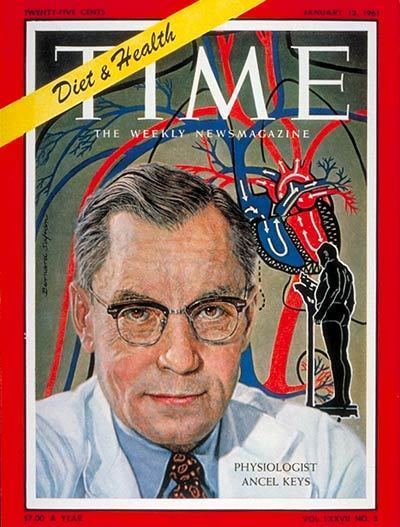
Ancel Keys was born in Colorado Springs in 1904 to Benjamin Pious Keys (1883-1961) and Carolyn Emma Chaney (1885-1960), the sister of Lon Chaney. In 1906 they moved to San Francisco before the 1906 San Francisco earthquake struck. Shortly after the disaster, his family relocated to Berkeley where he grew up. His intellect was well-known ever since a young age. Lewis Terman, a noted psychologist and inventor of the Stanford-Binet IQ Test, identified Keys as intellectually "gifted". During his youth, he left high school to pursue odd jobs, such as shoveling bat guano in Arizona, working as a powder monkey in a Colorado mine, working in a lumber camp, and working as a crewmember on a ship to China. He eventually finished his secondary education and was admitted to the University of California at Berkeley in 1922.
Higher education
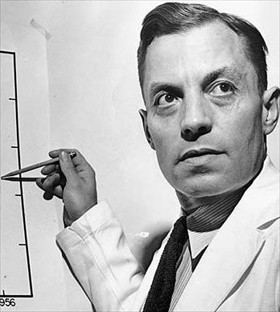
At the University of California, Berkeley, Keys initially studied chemistry, but was dissatisfied and took some time off to work as an oiler aboard the S.S. President Wilson (1st), which traveled to China. He then returned to Berkeley, switched majors, and graduated with a B.A. in economics and political science (1925) and M.S. in zoology (1928). For a brief time, he took up a job as a management trainee at Woolworth's, but returned to his studies at Scripps Institution of Oceanography in La Jolla on a fellowship. In 1930 he received his Ph.D. in oceanography and biology from UC Berkeley. He was then awarded a National Research Council fellowship that took him to Copenhagen, Denmark to study under August Krogh at the Zoophysiological Laboratory for two years. During his studies with Krogh, he studied fish physiology and contributed numerous papers on the subject. Once his fellowship ended, he went to Cambridge but took some time off to teach at Harvard University, after which he returned to Cambridge and earned a second Ph.D. in physiology (1936).
Early physiology studies
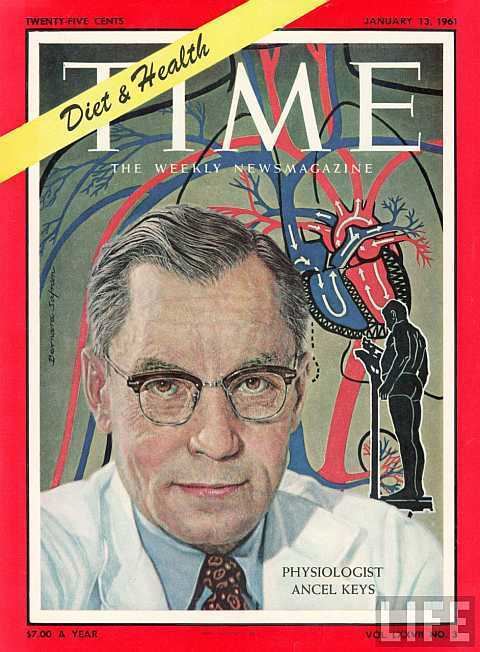
While doing fish research at Scripps, Keys would use regressions to determine the weight of fish from their length, a pioneering use of biostatistics at the time. Once in Copenhagen (1931), he would continue to study fish physiology and developed techniques for gill perfusion that provided evidence that fish regulated their sodium by controlling chloride excretion through their gills. He would also use this perfusion method to study the effects of adrenaline and vasopressin ("pitressin") on gill fluid flow and osmotic regulation in fishes. He also designed an improved Kjeldahl apparatus which improved upon Krogh's earlier design and allowed for more rapid determination of nitrogen content in biological samples. This would prove useful for activities as diverse as determining the protein content in grasshopper eggs and anemia in humans.
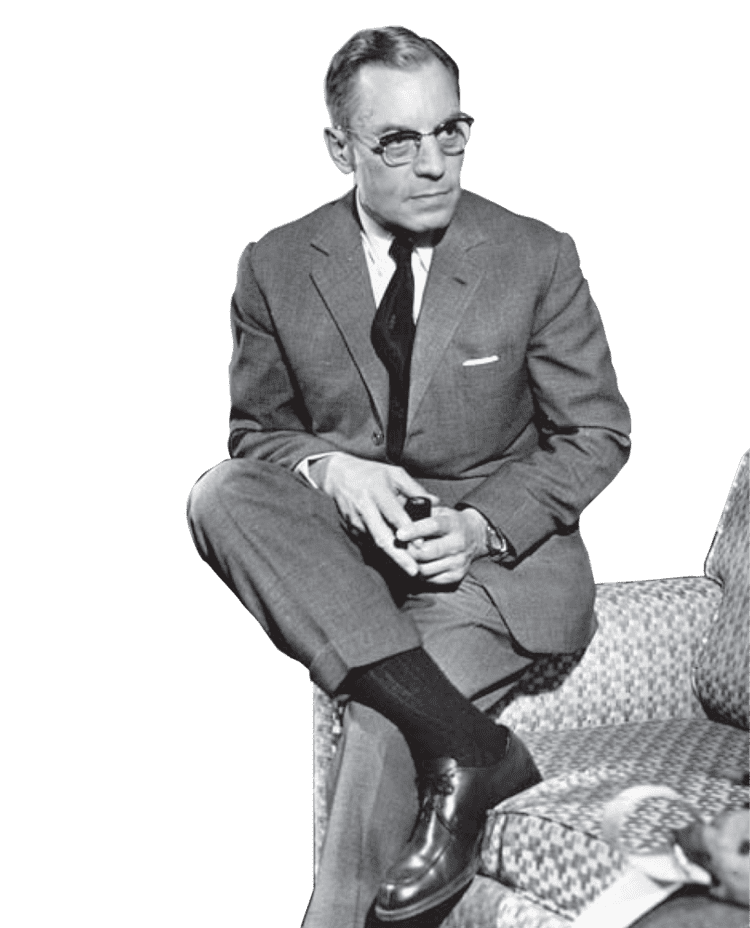
While at Harvard's Fatigue Laboratory, he was inspired by his Cambridge mentor John Barcroft's ascent to the top of Tenerife's highest peak and his subsequent reports. Keys wrote up a proposal for an expedition to the Andes suggesting the study could have practical value for Chilean miners that worked at high altitudes. He was given the go-ahead and, in 1935, assembled a team to study the effects of high altitude on the body, such as how it affects blood pressure. He spent a couple of months at 9,500 feet (3,000 m.) and then five weeks at altitudes of 15,000 to 20,000 feet (4,500 to 6,000 m.). He noted that there was no good way of predicting how well humans might adapt to high altitude, even if they adapted well to medium altitudes, which would be a problem for potential pilots in a time before pressure control. It was from these studies that he outlined the phenomenon of human physiological adaptation to environmental changes as a predictable event, a novel idea in a time when such things as blood pressure and resting heart rate were considered immutable.
Development of K-rations
In 1936 Keys was offered a position at the Mayo Foundation in Rochester, where he would continue to carry out his studies in physiology. He left after a year, citing an intellectually stifling environment where research was secondary to clinical "doc business" and playing bridge. In 1937 he would leave the Mayo Foundation for the University of Minnesota to teach physiology; He founded the Laboratory of Physiological Hygiene there. His earlier research on human physiology eventually led to an assignment with the Army Quartermaster Corps, where they worked to develop a more portable and nonperishable ration that would provide enough calories to sustain soldiers (such as paratroopers) in the field for up to two weeks. This development did not begin without some turbulence. His colleague, Dr. Elsworth Buskirk, notes:
Once the basic design had been completed, the Navy, through the National Research Council, funded the testing of the K-rations on its soldiers to determine its feasibility as a temporary and mobile food source. The initial ingredients of the K-ration were procured at a local Minneapolis grocery store—hard biscuits, dry sausage, hard candy, and chocolate. The final product was different from Keys' original ingredients, but most of Keys initial suggestions made it to the final product. The rations weighed only 28 oz (790 g), but provided 3200 calories per day. Though a few sources claim the name was unrelated to Keys, many historical references support the claim that the K-ration was indeed named after him. The K-ration became such a success that it was often used for more than temporary sustenance, becoming a major staple of military nutrition.
Starvation study
During World War II, Keys produced various studies related to human physical performance that were of interest to the military, such as studying the effects of testosterone on muscle work and vitamin supplementation as a performance enhancer on adequately fed soldiers, among many other similar studies. It was during the war that Keys and fellow researchers recognized the importance of knowing how to properly treat widespread starvation, since simple overfeeding for so many would be imprecise and there was a potential that the refeeding would fail.
To gain insight into the physiology of starvation, in 1944 Keys carried out a starvation study with 36 conscientious objectors as test subjects in the Minnesota Starvation Experiment. At the time, conscientious objectors were being placed in virtual concentration camps, with a few functioning like the Civilian Public Service, so that recruiting them would prove easier than seeking out volunteers in the general population. The original pool of 400 responders was reduced to 36 selectees, of whom 32 would go on to complete the study. The main focus of the study was threefold: set a metabolic baseline for three months, study the physical and mental effects of starvation on the volunteers for six months, and then study the physical and mental effects of different refeeding protocols on them for three months. The participants would first be placed on the three-month baseline diet of 3200 calories after which their calories were reduced to 1800 calories/day while expending 3000 calories in activities such as walking. The final three months were a refeeding period where the volunteers were divided into four groups, each receiving a different caloric intake.
The war came to an end before the final results of the study could be published, but Keys sent his findings to various international relief agencies throughout Europe and, by 1950, he completed publication of his two-volume 1385-page Biology of Human Starvation.
Seven Countries Study
His interest in diet and cardio-vascular disease (CVD) was prompted, in part, by seemingly counter-intuitive data: American business executives, presumably among the best-fed persons, had high rates of heart disease, while in post-war Europe CVD rates had decreased sharply in the wake of reduced food supplies. Keys postulated a correlation between cholesterol levels and CVD and initiated a study of Minnesota businessmen (the first prospective study of CVD). At a 1955 expert meeting at the World Health Organization in Geneva, Keys presented his diet-lipid-heart disease hypothesis with "his usual confidence and bluntness". Naples was the first case study that seemed to support his hypothesis.
After observing in southern Italy the highest concentration of centenarians in the world, Keys hypothesized that a Mediterranean-style diet low in animal fat protected against heart disease and that a diet high in animal fats led to heart disease. The results of what later became known as the Seven Countries Study appeared to show that serum cholesterol was strongly related to coronary heart disease mortality both at the population and at the individual level. As a result, in 1956 representatives of the American Heart Association appeared on television to inform people that a diet which included large amounts of butter, lard, eggs, and beef would lead to coronary heart disease. This resulted in the American government recommending that people adopt a low-fat diet in order to prevent heart disease.
Keys had concluded that saturated fats as found in milk and meat have adverse effects, while unsaturated fats found in vegetable oils had beneficial effects. This message was obscured for a 20-year period starting around 1985, when all dietary fats were considered unhealthy. This was driven largely by the hypothesis that all dietary fats cause obesity and cancer. A 2015 systematic review and meta-analysis by the Cochrane Collaboration, an organisation which promotes evidence-based medicine, found that reducing saturated fat intake reduced the risk of cardiovascular disease, concluding: "Lifestyle advice to all those at risk of cardiovascular disease and to lower risk population groups should continue to include permanent reduction of dietary saturated fat and partial replacement by unsaturated fats."
A 2013 systematic review and meta-analysis of randomized control trials by Cochrane also found that the Mediterranean Diet has some favourable effects on cardiovascular risk factors, but that more research is needed.
Keys equation
The Keys equation predicts the effect of saturated and polyunsaturated fatty acids in the diet on serum cholesterol levels. Keys found that saturated fats increase total and LDL cholesterol twice as much as polyunsaturated fats lower them.
The sugar controversy
In 1972, Pure, White and Deadly was published, written by John Yudkin for a lay readership. Its intention was to summarize the evidence that the over-consumption of sugar was leading to a greatly increased incidence of coronary thrombosis, and that in addition it was certainly involved in dental caries, probably involved in obesity, diabetes and liver disease, and possibly involved in gout, dyspepsia and some cancers.
Yudkin ended the first Chapter: "I hope that when you have read this book I shall have convinced you that sugar is really dangerous." This message was extremely unwelcome to the sugar industry and manufacturers of processed foods and these firms employed a number of methods to impede Yudkin's work. The final Chapter of Pure, White and Deadly lists several examples of attempts to interfere with the funding of his research and to prevent its publication. It also refers to the rancorous language and personal smears used by Ancel Keys to dismiss the evidence that sugar was the true culprit.
Keys wrote, for example:
"It is clear that Yudkin has no theoretical basis or experimental evidence to support his claim for a major influence of dietary sucrose in the etiology of CHD; his claim that men who have CHD are excessive sugar eaters is nowhere confirmed but is disproved by many studies superior in methodology and/or magnitude to his own; and his "evidence" from population statistics and time trends will not bear up under the most elementary critical examination. But the propaganda keeps on reverberating..." "Unfortunately, Yudkin's views appeal to some commercial interests with the result that this discredited propaganda is periodically rebroadcast to the general public of many countries."
The efforts to discredit the case against sugar were largely successful, and by the time of Yudkin's death in 1995 his warnings were, for the most part, no longer being taken seriously.
Yudkin's arguments and evidence for the dangers of sugar were the focus of several articles in the British Medical Journal of 19 January 2013.
In 2009, Robert Lustig, a pediatric endocrinologist of the University of California, San Francisco, Medical School who has a special interest in childhood obesity, made a video called Sugar: The Bitter Truth. Lustig had independently re-discovered and confirmed Yudkin's findings and, taking aim at Keys, asked his audience, "Am I debunking?"
BMI and other contributions
In a 1972 article, Keys and his coauthors promoted Adolphe Quetelet's body mass index (BMI) as the best of various indices of obesity, which the U.S. National Institutes of Health then popularized in 1985.
Keys was always considered an interventionist. He generally shunned food fads and vigorously promoted the benefits of the "reasonably low-fat diets" he contrasted with "the North American habit for making the stomach the garbage disposal unit for a long list of harmful foods." Because of his influence in dietary science, Keys was featured on the cover of the January 13, 1961 issue of Time magazine.
Personal life
Keys was an atheist. When Keys was hired at the Mayo Foundation in 1936, he hired Margaret Haney (1909–2006) as a medical technologist. In 1939 they married and had three children: Carrie D'Andrea, Henry Keys, and Martha McLain. Carrie became a clinical psychologist and Henry became a physician and cancer researcher. Both are well respected contributors to their fields. Martha was shot dead by a thief in 1991 when she was 42.
Together, Margaret and Keys co-authored three books, two of them bestsellers, Eat Well and Stay Well (Doubleday, 1959), The Benevolent Bean (Doubleday, 1967), and How to Eat Well and Stay Well the Mediterranean Way (Doubleday, 1975). They earned enough royalties to build Minnelea, their villa one hundred miles south of Naples. They also traveled the world, going to places like Japan and South Africa to record data for Ancel's published works such as the Seven Countries Study.
Keys also appeared on To Tell The Truth game show as the inventor of K-Rations, fooling two of the four panelists.
Keys died on November 20, 2004, two months before his 101st birthday. A year earlier, he had left Pioppi, his beloved village in the Cilento region located on the southwest coast of Italy, where he had spent 28 years of his life.
